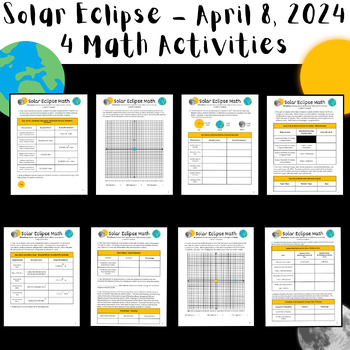Solar Eclipse 2024: 4 Math Worksheets - Middle School (Printable+Digital)
In Our Middle School Era
179 Followers
Resource Type
Standards
CCSS4.MD.A.1
CCSS4.MD.A.2
CCSS4.MD.A.3
CCSS5.G.A.1
CCSS5.G.A.2
Formats Included
- PDF
Pages
8 pages
In Our Middle School Era
179 Followers
What educators are saying
My students used this resource to set the stage for the eclipse. It had a lot of variety to keep students engaged.
Also included in
- This bundle is full of NO PREP resources to utilize for the Total Solar Eclipse occurring in 2024. Help your students enjoy and remember this special experience on April 8, 2024! These activities were designed for middle school age students, but can be used in upper elementary (with appropriate scaPrice $12.75Original Price $18.00Save $5.25
- This activity contains 7 NO PREP middle school math activities (six are front-back and one is 4 pages) related to the Solar Eclipse happening April 8, 2024. Each activity can be used separately, completed as stations, or as a packet of worksheets. These activities were designed for middle school, buPrice $5.00Original Price $7.00Save $2.00
- This activity contains 10 NO PREP middle school math activities (nine are front-back and one is 4 pages) related to the Solar Eclipse happening April 8, 2024. Each activity can be used separately, completed as stations, or as a packet of worksheets. These activities were designed for middle school,Price $7.50Original Price $9.50Save $2.00
Description
This activity contains 4 NO PREP middle school math activities (front and back) related to the Solar Eclipse happening April 8, 2024. Each activity can be used separately, completed as stations, or as a packet of worksheets. These activities were designed for middle school, but could be used for upper elementary (with scaffolding) or high school students in Pre-Algebra, Pre Algebra, Algebra, or Geometry.
These activities includes the following math skills:
- Probability - Fractions - Percentages
- Rotations on a Graph - Plotting Points on a Graph
- Scientific Notation and Standard Form
- Converting Units (length, time, speed, etc)
- Elapsed Time Word Problems
- Surface Area of a Sphere
- Radius + Diameter
- Data Analysis
Looking for more Solar Eclipse 2024 Activities? Try these! Solar Eclipse 2024 Growing Bundle - includes all activites below
- Solar Eclipse 2024 Coloring Pages (12 Options) - FREEBIE
- Solar Eclipse 2024 Crossword Puzzle - FREEBIE
- Solar Eclipse 2024 Observation Worksheet - FREEBIE
- Solar Eclipse 2024 True or False Trivia Activity (Printable)
Solar Eclipse - Reading and Writing Bundle and Activities
- Solar Eclipse 2024 Text Structure Activity Reading and Writing
- Solar Eclipse 2024: Reading and Writing Activity for Middle School
- Solar Eclipse 2024: Reading and Writing Task for Middle School (CER)
- Solar Eclipse 2024 Compare/Contrast Reading and Writing Activity - Middle School
- Solar Eclipse 2024: Eye Safety Middle School Reading/Writing Task
Solar Eclipse - Math Bundle and 10 Activities
- Solar Eclipse 2024: 6 Middle School Math Activities (Printable + Digital)
- Solar Eclipse 2024: 7 Math Activities - Middle School (Printable+Digital)
- Solar Eclipse 2024: 4 Math Worksheets - Middle School (Printable+Digital)
- Solar Eclipse 2024: 3 Math Worksheets - Middle School (Printable+Digital)
- Solar Eclipse 2024: 3 Math Worksheets - Middle School (Printable+Digital)
Total Pages
8 pages
Answer Key
Included
Teaching Duration
90 minutes
Report this resource to TPT
Reported resources will be reviewed by our team. Report this resource to let us know if this resource violates TPT’s content guidelines.
Standards
to see state-specific standards (only available in the US).
CCSS4.MD.A.1
Know relative sizes of measurement units within one system of units including km, m, cm; kg, g; lb, oz.; l, ml; hr, min, sec. Within a single system of measurement, express measurements in a larger unit in terms of a smaller unit. Record measurement equivalents in a two-column table. For example, know that 1 ft is 12 times as long as 1 in. Express the length of a 4 ft snake as 48 in. Generate a conversion table for feet and inches listing the number pairs (1, 12), (2, 24), (3, 36),...
CCSS4.MD.A.2
Use the four operations to solve word problems involving distances, intervals of time, liquid volumes, masses of objects, and money, including problems involving simple fractions or decimals, and problems that require expressing measurements given in a larger unit in terms of a smaller unit. Represent measurement quantities using diagrams such as number line diagrams that feature a measurement scale.
CCSS4.MD.A.3
Apply the area and perimeter formulas for rectangles in real world and mathematical problems. For example, find the width of a rectangular room given the area of the flooring and the length, by viewing the area formula as a multiplication equation with an unknown factor.
CCSS5.G.A.1
Use a pair of perpendicular number lines, called axes, to define a coordinate system, with the intersection of the lines (the origin) arranged to coincide with the 0 on each line and a given point in the plane located by using an ordered pair of numbers, called its coordinates. Understand that the first number indicates how far to travel from the origin in the direction of one axis, and the second number indicates how far to travel in the direction of the second axis, with the convention that the names of the two axes and the coordinates correspond (e.g., 𝘹-axis and 𝘹-coordinate, 𝘺-axis and 𝘺-coordinate).
CCSS5.G.A.2
Represent real world and mathematical problems by graphing points in the first quadrant of the coordinate plane, and interpret coordinate values of points in the context of the situation.








